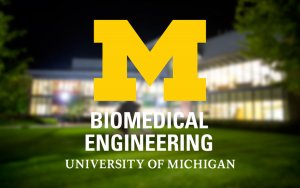Presented By: Biomedical Engineering
Non-Invasive Venous Thrombus Composition and Therapeutic Response by Multiparametric MRI
Final Oral Examination - Olivia Palmer

Deep vein thrombosis (DVT), or a blood clot in a deep vein (commonly the legs), is known as the silent killer—there may be few or no symptoms, yet a section of the thrombus could break free and travel to the lungs causing a potentially fatal pulmonary embolism. DVT and its complications affect 900,000 people in the U.S. each year, with one third of cases resulting in fatality. Anticoagulants (the standard treatment) pose serious bleeding risks and rely on the patient’s fibrinolytic system to break up the thrombus, which is often incapable of doing so thus leading to post thrombotic syndrome (PTS) in almost 50% of patients. Removing the DVT completely via thrombolytic treatments may improve quality of life by reducing PTS. However, thrombolysis is only effective on acute thrombi. Impaired success with thrombolytic treatment is due to heterogeneity in the thrombus (old clot, which is unable to be broken up, intermixed with fresh clot, which can easily be broken up). This problem is largely overlooked based on an inability to determine thrombus composition.
Currently, the only method for determining disease stage is the patient’s recollection of when their symptoms began, which is inherently unreliable and could put the patient at risk. Further, thrombi of the same chronological age may organize at different rates in different people. Magnetic resonance imaging (MRI) has the potential to provide information about thrombus composition (clot age), and thus inform patient-specific treatment planning.
Since there are several limitations to studying DVT in humans, animal models are key tools for understanding the disease. Mouse models are the most commonly used, providing a unique biological environment to study disease progression and treatment. Any model requires rigorous characterization and standardization to ensure reproducibility between studies. Our first objective was to quantify structural and functional changes in the healthy venous system of young and aged mice of both sexes, at rest and under conditions which simulate exercise. Second, we assessed the endogenous response to two models of DVT mimicking the two possible clinical scenarios: total or partial occlusion.
Following the necessary model characterization, we developed a multiparametric MRI approach to probe thrombus composition without the need for contrast agents. Our results show imaging correlation with known composition by histology. This method provides a novel approach to study thrombus composition, and could eventually be used clinically to provide patient-specific treatment planning for DVT.
Additionally, we investigated the impact of exercise, an emerging therapeutic option, on thrombus composition. Using an in-cage running wheel, our results show that spontaneous exercise – both alone and in combination with standard treatment – reduces initial thrombus size and contributes to thrombus resolution. We found that exercise increases acute fibrin content, attenuates local inflammation, and decreases sub-chronic collagen content in pharmacologically treated mice.
This work provides 1) the first in vivo characterization of the murine venous system in health and disease, 2) a foundational methodology to determine thrombus composition by MRI, and 3) insights on the impact of exercise on DVT. This research can help DVT investigators from the animal model perspective, and provides a step forward in characterizing thrombus composition for patient-specific DVT treatment planning.
Co-Chairs: Joan Greve and Jose Diaz
Currently, the only method for determining disease stage is the patient’s recollection of when their symptoms began, which is inherently unreliable and could put the patient at risk. Further, thrombi of the same chronological age may organize at different rates in different people. Magnetic resonance imaging (MRI) has the potential to provide information about thrombus composition (clot age), and thus inform patient-specific treatment planning.
Since there are several limitations to studying DVT in humans, animal models are key tools for understanding the disease. Mouse models are the most commonly used, providing a unique biological environment to study disease progression and treatment. Any model requires rigorous characterization and standardization to ensure reproducibility between studies. Our first objective was to quantify structural and functional changes in the healthy venous system of young and aged mice of both sexes, at rest and under conditions which simulate exercise. Second, we assessed the endogenous response to two models of DVT mimicking the two possible clinical scenarios: total or partial occlusion.
Following the necessary model characterization, we developed a multiparametric MRI approach to probe thrombus composition without the need for contrast agents. Our results show imaging correlation with known composition by histology. This method provides a novel approach to study thrombus composition, and could eventually be used clinically to provide patient-specific treatment planning for DVT.
Additionally, we investigated the impact of exercise, an emerging therapeutic option, on thrombus composition. Using an in-cage running wheel, our results show that spontaneous exercise – both alone and in combination with standard treatment – reduces initial thrombus size and contributes to thrombus resolution. We found that exercise increases acute fibrin content, attenuates local inflammation, and decreases sub-chronic collagen content in pharmacologically treated mice.
This work provides 1) the first in vivo characterization of the murine venous system in health and disease, 2) a foundational methodology to determine thrombus composition by MRI, and 3) insights on the impact of exercise on DVT. This research can help DVT investigators from the animal model perspective, and provides a step forward in characterizing thrombus composition for patient-specific DVT treatment planning.
Co-Chairs: Joan Greve and Jose Diaz